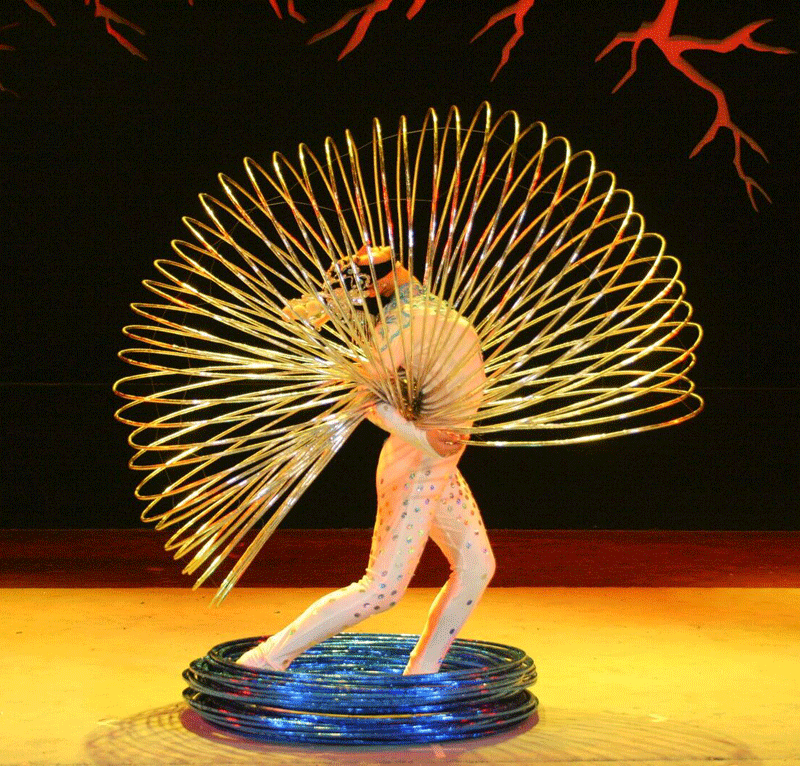Anyone who has been to the circus knows what it feels like to clench your fists and hold your breath when the acrobats walk the tightrope or fly across on the trapeze. Just thinking about it can give you belly butterflies.
After the show, audience members often find themselves with one question: “How do they do it?”
Jessy Chou, the Acrobats of China marketing and touring manager, shared the ancient Chinese secret of acrobatic perfection with whatzup and here it is: there is no secret.
The award-winning Acrobats of China dedicate their lives to acrobatic training to astonish crowds with their impossible performances.
While the audience may be captivated by the graceful hat spinning, hoop jumping and drum juggling, make no mistake, these acts are not as effortless as they appear. The success of their dazzling performances relies on the years of preparation the acrobats devote themselves to.
“They went to the acrobatic school in China since they were like five or six years old,” Chou said. They practice until skilled enough to perform, training eight hours per day.
How else could children evolve into professional acrobats if not for years of discipline to the art? In fact, a typical acrobatic student does not perform until about 12 years old, at which point they have been training for six-plus years.
“There was one time we were having a show in New York, and there was a technician, and he asked me, ‘How could they know which one of them is talented enough to be on the stage?’ and I say, ‘They don’t need talent. They just keep practicing and training until they have the ability to be on stage, so welcome to China.'”
Clearly, for the Acrobats of China, there is no such thing as a gifted and talented acrobat. In this business, training is a full-time job and achievement is earned through blood, sweat and tears.
The biggest challenge for the Acrobats of China, according to Chou, is having enough strength to carry out an act. However, you will not find these performers pumping iron at the gym. Instead, they build their muscular endurance by lifting one another and contorting themselves into impossible positions.
“The contortion is really painful,” Chou said, describing a feat only an Olympic gymnast could hope to execute.
Even with extensive training and impressive strength, performances do not always go as planned. Chou said, “Sometimes when they do the Chinese yo-yo they fall … and with the hat juggling, sometimes they cannot catch the hat. So a technician just said, ‘It will be better if they fall so the audience knows that it is really hard.'”
On the off chance the Acrobats of China cannot complete an act to perfection, they simply try again, showing off their super-human skills.
With these fantastical feats the acrobats bring a glimpse of China to the United States. Acrobatics have been a part of Chinese culture for 2,300 years. Today’s acrobatic maneuvers pay homage to the ancient performances of acrobats past as well as Chinese history, literature and tradition. Acts such as hoop diving, pole climbing, human juggling and group bicycling allow the audience to peer into the rich history of China.
Headquartered in Branson, Missouri, the Acrobats of China carry a particular prestige, as they were the first to bring a Chinese acrobatic show to the United States. And since then, they have been leaving crowds speechless with their breathtaking performances.
Chou herself was surprised at how captivated she was the first time she watched the Acrobats of China.
“In my mind I thought acrobatics shows were boring,” she said, “but no, the first show I saw from Jinan Troupe [Acrobats of China] was really beautiful.”
Not only did that first show mesmerize her, but the performances continue to thrill this tour manager. “I watch the same show every time and I never get bored,” Chou said. “I’m like addicted to it.”
And the audiences feel the same way.
“They love it, Chou said. “I know they love it.”
After each show, the acrobats receive an extended standing-ovation, with audiences jumping to their feet, clapping in disbelief.
“Every time during the curtain calls the audience will stand and clap their hands until the curtain call is over,” Chou said.
The adoration from the crowd does not seem to phase the Acrobats of China. After all, this is what they do. When the curtain closes, the acrobats promptly switch gears to get ready for the next performance.
“They don’t celebrate because we don’t have time, we just need to start packing,” Chou said. “We will have to put all the things into a van and start driving.”
With unparalleled focus and professionalism they review their performance from that evening, using the feedback to capture the next crowd.
Incidentally, The Acrobats of China are able to connect with their audiences without speaking a word. Each acrobat comes from China and speaks little to no English. Their playfully charismatic performances do the talking for them.
One time, Chou overheard some stage technicians talking derogatively about some of the acrobats, which she refers to as “her kids.” Turning her ear away, Chou chose to focus her energy on the upcoming performance. When the curtain finally closed to tumultuous applause as it had so many times before, it seemed those same technicians had a change of heart.
“All the technicians that made fun of our troupe came and shook hands, almost with tears, I’m not kidding,” Chou said. “Right after the show the meanest one just came and shook my hand and said, ‘That was amazing, I am looking forward to working with you again.'”
By delivering dynamic and compelling shows the Acrobats of China are closing cultural gaps, dazzling viewers as they go.
“They don’t need to even speak a word, they don’t need a microphone on stage,” Chou said. “When you turn on the light, they can act.”
 Submit Your Event
Submit Your Event




